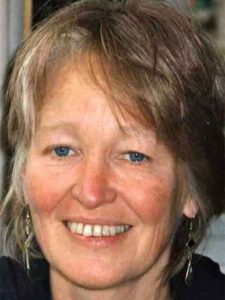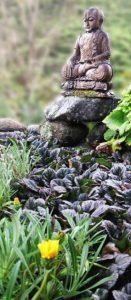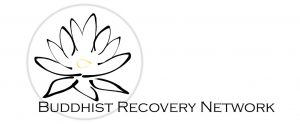While researching current events in the international Buddhist recovery community, our author came across a radio interview with Navachitta, a teacher and Buddhist Recovery meeting facilitator at the Aukland Buddhist Center in New Zealand, He decided to contact Navacchita, who agreed to share her views about Buddhist Recovery and this rapidly growing movement in the recovery community. The following is from a Skype interview in July of 2014.

NWBR: First of all, thanks so much for sparing the time to speak to the NWBR sangha.
NAVACHITTA: You’re welcome. I’m very happy to be asked.
NWBR: Could you start by telling us a bit about yourself, about your background and how you came to be involved in Buddhism and in recovery?
NAVACHITTA: Well, I first came in contact with Buddhism in 1981 and I was ordained into the Triratna Community in 1990. I have a degree in alcohol and drug studies and I’m a drug and alcohol clinician. I’ve also trained in Mindfulness-based Relapse Prevention [MBRP] in the US. We’re working hard to get that more accepted here in New Zealand. For as long time I worked in the Public Health Service, but I felt I had to compromise myself too much. Eventually I left and went into private practice. I’m still a contractor in Public Health.
I became personally involved in addiction because I come from a long time of Irish and Scots alcoholics – mainly in the maternal line – right back to the Potato Famine. And I grew up in a household with an alcoholic parent. There was a lot of fighting and there was a lot of suffering all-round, because it’s never just the addict who suffers.
I was an adolescent in the 70s, which was still something of a rampant time, so that’s when I got into my own strife with just about every substance I could get into me. I came into contact with the Dharma when I was 28. I knew I didn’t want the lifestyle I was living. I had a daughter by then and I wasn’t behaving very well. I’d been living in France with my then husband and because of substance issues that really wasn’t going very well at all. I came home back to New Zealand and still I couldn’t really make anything work. I was just getting more and more confused and desperate. I knew I had to do something but there were no 12-Step groups, at least that I knew of.
As soon as I got involved in Buddhism, I was pretty much clear very quickly. I just cleared out all my bottles and decided to change my life.
As I listened to The Dharma I could see the reasons for all this existential angst I’d been suffering though. I had a wee glimpse of reality with a capital “R” and everything seemed, quite suddenly, to make sense. I was one of the lucky ones.
Now I do a lot of teaching here at the Auckland Buddhist Center. I facilitate two Buddhist Recovery meetings a week as well, which are becoming more and more popular.
Our Sunday meeting, which is the larger, has about thirty regular members and then, during the week, we have about a dozen people.
 NWBR: In the 80s, when you were looking for help, you couldn’t find any 12-Steps groups to join. What the situation like now in New Zealand?
NWBR: In the 80s, when you were looking for help, you couldn’t find any 12-Steps groups to join. What the situation like now in New Zealand?
NAVACHITTA: There’s a very strong 12-Step presence in New Zealand now and the program has helped a lot of people over the years. If you work the steps it’s a very effective program for many many people.
NWBR: What sort of problems do people have with traditional 12 steps in your experience?
NAVACHITTA: In New Zealand I think we’re quite lucky because we’re not as overtly Christian here as people are in other places – like the US for example. We have a larger proportion of Humanism and Atheism, I think, and Agnosticism and Rationalism and even Paganism. So sometimes when people come into a traditional 12 step meeting there can be a bit of a disconnect because right away they’re face with the use of the word and ideas of God in the steps. Some of the people who are now members of the ABC Recovery Sangha have funny stories about when they tried to make the idea of God work for them in early recovery. But then there was no alternative. They had to really give it a go because it was a matter of life and death for some of them.
But when they found out that you don’t have to walk ‘round “talking to the ceiling” as one of our members thought, and that’s a huge relief for a lot of people. But for some people the language that’s used can be a barrier in that it comes out of a different time and, in some ways, a very different mind set, the Judeo-Christian mind-set and the mind-set of 30s America. Some people have difficulties with the idea of dualist power, a hierarchical power, a masculine power somewhere out there, unseen. But, obviously there are a lot of very good things about traditional 12-Step.
NWBR: How do you see your programs working in relation the traditional AA, OA, NA ideas?
NAVACHITTA: Our program at Auckland Buddhist Centre can be a great adjunct to the 12 steps. It’s not necessarily a replacement. The steps have worked beautifully for a lot of people over the years. And in both cases, at ABC and in 12 Steps, the work is the work of surrender. In both cases it’s still about tackling the ego – the small self – and getting that out of the way so there can be a breakthrough. The small self needs to make way for the larger self.
NWBR: Tell us about the founding of Buddhist Recovery Network in Auckland in 2011.
NAVACHITTA: I was working as a clinician and I felt that I was being ground down, more and more, by very high caseloads and the bureaucracy. I was also in the comfort zone of enjoying a good salary and having status. But I felt I wasn’t being congruent with being an ordained Buddhist. So I decided that I’d just leap out of the security blanket I’d made for myself and go into private practice. I already felt very strongly that the Dharma could be a huge benefit to people who suffer as much as addicts and alcoholics do. And it was obvious, with my family background and my clinical training, that sharing The Buddha, The Dharma and The Sangha to help people in recovery was what I was on the planet to do. So, one day, I simply Googled “Buddhist Recovery”. I was delighted to see that a lot of work had been done already around combining the power of those three ideas. Obviously there was no need for me to reinvent the wheel. I saw the work Paul Saintilan had done in Australia. He’d founded the Buddhist Recovery Network website there. I was really inspired by what I found and I started the recovery groups at ABC. I knew a lot of people who work in the drug and alcohol field so I reached out through them. I was teaching in that field as well so I would tell people about our groups and about what we were trying to do. I wasn’t proselytizing for Buddhism per se, but I would suggest they come and learn to meditate because it’s the 11th step, “[We] sought through prayer and meditation to improve our conscious contact with God as we understood Him, praying only for knowledge of His will for us and the power to carry that out.” In the beginning sometimes no one would come at all. I’d sit there all by myself. When people did start coming along I found there was an awful lot of confusion about what meditation actually is. Quite often people saw it as a means of escaping reality whereas it’s a method of investigating reality. When you face reality you’re much more able to address the things you’ve been running away from, perhaps for your whole life. I would explain how meditation is, in part, about using the mind to work on the mind. That’s a novel concept for many people because that’s where their suffering arises from.
Another thing that was tricky for people in early recovery — or if they’ve got some time but are new to Buddhism — is the idea of taking refuge. But they get it when they see that they’ve been taking refuge in all sorts of things that have let them down – that are unsustainable. We go to refuge to delusion instead of to truth. So, it quickly becomes obvious that if you’re going to go for refuge you’re better off going for refuge to something that works and is sustainable.
NWBR: What are people’s hopes and fears and misconceptions when they come to Buddhist recovery?
NAVACHITTA: I lot of people want a quick fix – they’re addicts after all so it’s not surprising that that’s what they’re after – so we do what we can to break that one down rather rapidly. They also tend to over-intellectualize. They come in with the raft of preconceived notions and engage in a lot of intellectual gymnastics. But what really makes a difference is when they can find an emotional equivalence to their intellectual understanding. A lot of people – and especially addicts – have over-developed intellects and under-developed emotions. We meet a lot of forty year old sixteen year olds. As far as what their hopes are when they come in — well what they all really want is just a break from suffering. A lot of people are depressed or perhaps they’re dealing with anxiety attacks. We had one woman who came to us and she was so anxious and nervous she couldn’t even go to the supermarket because she’d just get overwhelmed. She came along and she started meditating and she was conscientious in working the program and she’s vastly improved her quality of life in just a few months. That’s happened because she’s been willing to develop a regular practice. That’s one of my big challenges; to get people to realize that it’s not a quick fix, this is something that you have to come back to over and over. You have to find a way to develop a regular mediation practice and it’s not such an easy thing to do. People in early recovery can be surprised that their life didn’t just become a bed of roses because they finally managed to stop using. But we can offer them at set of really tried and tested tools for being able to just be with the whole rollercoaster ride of their newfound sobriety. We do a lot of body scan guided meditations. There’s a lot of wisdom in the body and we find that it’s especially helpful in dealing with relapse prevention because if you can learn to be aware of what’s going on in your body before the runaway thoughts and overwhelming emotions kick in you’re going to be much more able to stop yourself winding the whole thing up into a great big melodrama which is going to make the relapse so much more likely.
Another thing that is very important is that the space itself feels safe. We took a lot of care in making our meditation hall exquisitely beautiful and people come to know it as a place of safety – as a real refuge. So we say; just come as sit still. If you’re mind’s all over the place, well just accept that it’s all over the place and keep sitting still. And then the friendship element can’t be overemphasized. It can take a while, but now we have some fantastic people who hang out after we’ve sat and hand out cups of tea and engage in dynamic conversations and people are lapping it up. It feels a bit like we’ve let this genie out of a lamp because it’s working so fantastically and so many people are benefitting from it.
NWBR: It can be pretty tough to take a look at our minds when we’re new mediators. Have you found that it’s ever not appropriate to engage in that level of self-inquiry for somebody new to recovery?
NAVACHITTA: We start off with Samatha mediation, which is all about calming the mind. We don’t start off with Vipassana -insight – meditation. We’ve found that a problem with coming to insight meditation too early can be that your mental states are not positive enough. So we put the emphasis on Samatha and on Metta -loving kindness. And if there’s any trauma in the background, we also advise that people keep their eyes open while they sit. And we make sure they do what they just work at a level that they’re happy with. They don’t need another source of stress in their lives. Although we don’t have clinical responsibility we do our best to keep in contact with people outside of the sessions at the center. What we’re aiming for in the beginning is stabilizing the mind. We want to foster a sense of safety and protection and kindness and so, in the beginning, Samatha and Metta practice is really the key.
NWBR: What have people found most challenging when they compare what they’re asked to take on in Buddhist recovery and what they’re faced in Traditional 12 step?
NAVACHITTA: Well one thing they have to be willing to do in both cases is to do the work. In 12 step, it’s work the steps and to get the benefits. When they come to meetings at the Auckland Buddhist Center, they have to do the meditation, follow the precepts as best they can, come on retreat – and all that can be quite onerous. Perhaps one of the big differences is between prayer in the 12 Steps and the meditation we offer. Prayer can be a bit like bargaining sometimes. You do your bit by asking – by praying – and then there’s often the expectation that God will sort everything out for you. I think in Buddhist recovery our point of view is that you need to take responsibility for your own states of mind and to realize that what you think, what you say and what you do all have consequences. We’re clear that when you act unskillfully you’re going to suffer and when you act skillfully you don’t. Another distinction is how important it is in our view to just be with the suffering. It’s not necessary – or even desirable – to get rid of it as fast as you can. And we show people how that works in very simply ways. For example, if you can sit with a itch in meditation and just be with the experience of the itch as fully as you can be and be with the urge to scratch it and alleviate the suffering then, through that practice, you’re really training yourself to not scratch the first “using” itch you have. As addicts we’re so used to being enslaved to our mind’s demands that when, in training the mind, we try to establish a semblance of order and stability it can be very challenging. But we help people to see that every difficulty and every challenge is an opportunity to practice. Every time the mind wanders it’s an opportunity to gently bring it back and every time you bring it back you’re making progress.
NWBR: What’s the relationship like between the people in recovery and the other members of the sangha at ABC?
NAVACHITTA: The Auckland Buddhist Center has been transformed by our recovery people. What I’ve noticed is that there’s such a sense of discipline and a sense of being engaged in a noble quest that is much more pronounced among the people who are in recovery and those who aren’t.
NWBR: How would you respond to people who say that people in Buddhist recovery are just exchanging one mythical, unattainable super-being for another?
NAVACHITTA: Well that point of view would be rooted in a misconception about what and who The Buddha is. The Buddha that we see sitting up their on the shrine is not God. He’s not the deity, or divine or the son of God or the prophet, he’s non-theistic. He’s a human being who showed what’s possible for other human beings. He’s an archetype of transcendent calm, and stillness and possibility. In our groups we’ve taken God out of our serenity prayer. We simply say; “Grant me the serenity …”. We’re simply calling upon our own intrinsic goodness. It’s funny because the absence of God can be a bit worrying to first-timers. They’re so often used to having to deal with “the God thing” and with us it’s not an issue they have to grapple with at all. It can be a great relief.
NWBR: Buddhist recovery is often described as 11th Step recovery because of its emphasis on meditation. In traditional 12 step, the 11 step doesn’t seem to get nearly as much attention as, for example, the steps that concentrate on inquiry into apparent “defects of character” and working them out through the personal inventory. Why do you think that is?
NAVACHITTA: I think it’s because we’re taught to be doers. When there’s a problem, you’re meant to do something about it. It’s seen as a virtue to always be doing things. But sometimes it can be better to be still and listen and tune into the deeper aspects of ourselves. But we’re not normally taught to that and so we don’t normally have that as an option. And if people do practice the 11th step then they most often will have a go at the prayer and ignore the meditation because prayer is something that is much more likely to be part of their cultural background and something they feel they know how to do. And maybe too it’s because by the time you’ve got up to step eleven you’re thoroughly fed-up with the steps so you’d rather just have a nice cup of tea. But we’re having such a lot of success with meditation here. People are just not relapsing as much.
NWBR: If it’s true that the 12 steps would be more accessible if they got rid of God, why wouldn’t you be more successful if you took Buddhism out of Buddhist recovery?
NAVACHITTA: There’s probably never going to be a perfect recovery program and perhaps for some people Buddha will be as difficult as God. But I come back over and over to the four noble truths and make it as clear as I can that Buddha is not a God. The fact is that the four noble truths are all about suffering – that suffering exists, that craving is the cause of suffering. I mean that’s perfect for the addict! They can really relayed to the first two. Then we say that there is the possibility of the end of suffering – three – and that the Noble eight-fold path is the means by which suffering ends. And I think it would be disingenuous to lay out that path and to not acknowledge the author.
NWBR: Apart from the success you’ve enjoyed in helping people maintain their sobriety, what other benefits have you seen for the members of your sangha who are in recovery?
NAVACHITTA: It’s interesting because I think that in our recovery groups the recognition that ego clinging is such a problem means that the conversations that we have tend not to be about ego matters. We just discuss The Dharma and we don’t tend to get caught up so much in a lot of ego issues. Sometimes 12 Step meetings can be very self-indulgent affairs, to be honest. Another thing – apart from staying sober — is that if they’re developing a regular meditation practice and being active members of the sangha and studying The Dharma, then their anxiety and their depression and their cravings just don’t seem to be anywhere near as much of a problem for them.
NWBR: What does the future look like for Buddhist recovery?
NAVACHITTA: I don’t know how things are in Seattle and the Northwest US, but New Zealand is awash with alcohol. And its abuse is the cause of so much strife and suffering. There’s so much domestic violence … the car crash situation is diabolical … there’s suicides, you name it. We have a growing methamphetamine problem too. And of course for every suffering addict there’s maybe another half a dozen or so in their sphere who are having a terrible time because too. So there’s a lot to do. We’re organizing more and more retreats and we’re working hard to develop MBRP and we’re trying to find ways to bringing it much more into the mainstream. With such a comparatively small populations in New Zealand – about four million – it’s a bit easier to get the word out to a big percentage of the people. There are a growing number of therapists and psychologists and even some lawyers who are enthusiastic about recommending MBRP or MBSR or Buddhist recovery programs to their clients. We’ve been up and running for three years now and so there are people in recovery in our sangha who are beginning to be ready to, in the next couple of years perhaps, to teach. And there’s something very powerful if you’ve been in the trenches yourself. It’s sort of like having the right credentials. People know you’re coming from a place of personal experience. So all in all I think the future is really very bright.
The Auckland Buddhist Centre is part of a worldwide movement called the
Triratna Buddhist Community. Triratna was founded over 40 years ago in the UK by
Sangharakshita, a Westerner with an eclectic Buddhist background. He was ordained in
India as a Theravadan monk in 1950, and requested Bodhisattva ordination there in 1962.When many eminent Tibetan Llamas escaped into India, he was one of the first Westerners to meet them and receive teaching and initiation in the Vajrayana tradition.


